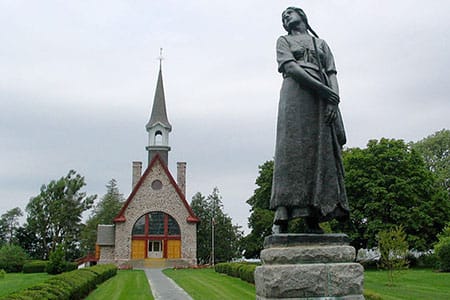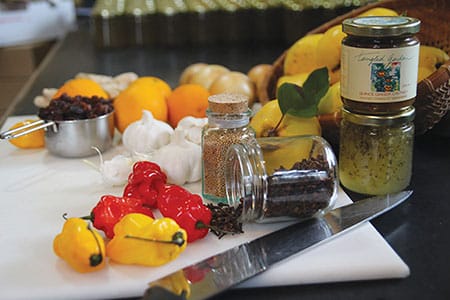Fertile and fragrant—apples and grapes
“My ancestors did all that work,” says interpretive guide Francois Gaudet as he looks out over the 3,200 acres of farmland surrounding the modern Grand-Pré Interpretive Centre. Francois is a descendent of the French Acadian settlers who built an ingenious dyke system between 1682 and 1755 to claim these fertile fields from the 14-metre (42-feet) tides of the Bay of Fundy. “They changed the land, and the land changed them,” says Francois.
Recently named one of North America’s newest UNESCO World Heritage Sites, Grand-Pré is a perfect start to a foodie tour of Nova Scotia’s Annapolis Valley because here, as it is throughout, food comes with a side of history.

Today, farmers grow corn, soybeans and wheat on 300-year-old fields said to be five times more fertile than fields cleared from forests. Few if any of the farmers are of Acadian descent because in 1755 the British brought a sudden and violent end to the French occupation of their hard-won farms during the Grand Dérangement—or expulsion—of the Acadians. Route One, or the Evangeline Trail, (named for Henry Wadsworth Longfellow’s fictional character separated from her love during the expulsion) runs the 150-kilometre length of the Annapolis Valley that starts here in Grand-Pré and ends at the Annapolis Basin in Digby.
 Sandwiched between two ancient and worn mountain ridges, the Valley’s microclimate is Canada’s third most important fruit growing region. It's famous for its many apple orchards, vineyards and other produce on more than 1,000 farms, (most modest and family-owned) its many U-picks, fruit stands, farmers markets and 11 wineries.
Sandwiched between two ancient and worn mountain ridges, the Valley’s microclimate is Canada’s third most important fruit growing region. It's famous for its many apple orchards, vineyards and other produce on more than 1,000 farms, (most modest and family-owned) its many U-picks, fruit stands, farmers markets and 11 wineries.
Less than a kilometre from the Grand-Pré site is Domaine de Grand Pré, the first winery established in Nova Scotia, which specializes in grapes like L’Acadie Blanc, well suited to the area's climate and landscape. Nearby is a vibrant shop and gallery, the rustic Tangled Garden, specializing in delicacies like strawberry lavender jelly and herbal liqueurs. A stroll in their creatively designed garden out back is a must for most visitors to the Valley.
Here on a Saturday morning, musicians jam at one end of the Wolfville Farmers' Market. They’re surrounded by laid-back, cheerful shoppers sipping coffees and munching any number of hot, homecooked treats. A Moroccan woman sells samosas, a baker his decadent German desserts. There’s fresh bread, local honey, spicy kimchi, spring rolls and in one corner the most colourful vegetable display I’ve ever seen. Similar mixes of produce, ready-to-eat treats and culture are found at farmers markets in Kentville, Harbourville, Bridgetown and Annapolis Royal.
Two of the many family-owned, single-farm markets are my Valley favourites. On the west side of Wolfville toward New Minas at the intersection of highway 358, Noggins Corner Farm never fails to please. The produce inside the shop is always fresh as if the apples have just been plucked from the trees and the carrots from the earth. The affordable prices always have me feeling like I’ve found the best deals.
Forty kilometres west, Allison Maher’s inventive and quirky Dempsey Corner Orchards near Aylesford is known for abundant fruit U-picks like high-bush blueberries and strawberries where, Allison says, “Sampling isn’t stealing.” Up the side of North Mountain, pears, 57 varieties of apples and a prolific peach orchard bend laden branches to the ground. Depending on the season, you can bottle-feed a baby goat, let the kids loose in the tire-themed playground called Firestone Henge or try your hand at apple golf.
The corn maze at Evans Family Farm Market between Kingston and Middleton claims to be the largest in the Valley. Visible from the air as a whimsical sketch on the land, the family hosts laser tag, zombie walks, haunted and trick or treat days in their maze, in addition to the usual U-pick fare, everything from strawberries to pumpkins.
In Annapolis Royal at the west end of the Valley, the Historic Gardens is a 17-acre living interpretation of the region’s rich cultural and agricultural history. Named one of North America’s best gardens, the themed sections tell the story of pre- and post-European settlement and showcase methods, designs, materials and plants from specific periods. The best known of these, the rose garden, attracts admirers from far and wide.
A final stop on a food-lover's tour of the historic Annapolis Valley is Digby, the self-proclaimed “Scallop Capital of the World.” This fishing town is a great place to rest after a busy tour through the verdant valley where every bite is a taste of history. Tuck into a traditional Nova Scotia supper of pan-fried scallops. Any number of restaurants here can fix you up as they’ve been doing for nearly a century.



